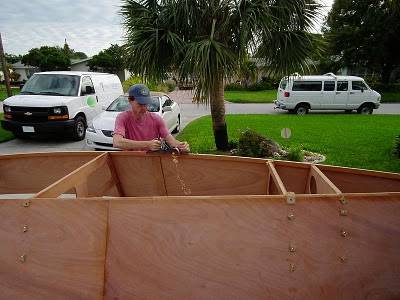Up on sawhorses
From the stern
The deckplate cutouts provided the perfect place to clamp the boat to the sawhorse for stability.
Having at the chinelog. Cedar is so easy to work with a sharp plane.
Planing around
Used a long level to check that the bevel angle planed into the chinelogs was just right for the bottom panel to lay flush.
I decided to plane down to the outside edge of the ply rather than planing to the inside edge. I did this mainly out of laziness but also because the bulkheads were aligned with this edge so it saved a lot of planing of the bulkheads. The little void will be filled with thickened epoxy which may, as a side benefit, toughen up the chine some and help prevent denting from rocks etc...... maybe.
We trial fitted the boat to it's trailer. The trailer is our old kayak trailer so now we will have to load kayaks up onto the roof rack. That's no fun but we can't have any more trailers in the yard :-) I'm planning on replacing the tongue with a slightly longer one and extending some wooden bunks aft to support more of the stern. The boat will live on this trailer for the rest of the build which makes it easy to move around.
Total time to date: 205hrs





































